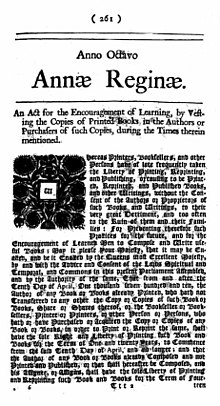Statute of Anne
The English Statute of Anne (full title: An Act for the Encouragement of Learning, by Vesting the Copies of Printed Books in the Authors or Purchasers of such Copies, during the Times mentioned therein ) is considered the first modern copyright law . It came into force on April 10, 1710.
For the first time, the author's right to his work was formulated in it, which had previously been with the booksellers ' guild ( Stationers' Company ). According to the preamble, the purpose was "the Encouragement of Learning," that is, to promote education. This purpose was to be achieved by granting the respective authors or the purchasers of this right the exclusive right to print for the time specified by law. The Stationers' Company was weakened by the Statute of Anne, since the guild's exclusive right to print was finally revoked and printing rights could also be traded outside the guild.
The law found that printers, booksellers, and others had recently taken the liberty of publishing books without obtaining the consent of the authors or other owners of the fonts, which had been damaged or ruined. In order to prevent these occurrences and to encourage scholars to write useful books, the law was passed. There are three aspects mentioned, namely
- the promotion of education (“Encouragement of Learning”);
- encouraging scholars to write useful books ("Encouragement of Learned Men to Compose and Write Useful Books");
- the prevention of financial disadvantages for authors or users of rights through reprinting by granting them a temporary right of exclusion ("by vesting the copies of printed books in the authors or buyers of such copies, during the times mentioned therein").
For new works, the law limited the term of protection to 14 years. After its expiry, the living author was entitled to an extension of another 14 years. The deadline began with the first publication, not with the creation of the respective work. It expressly states that the protection should end when the period expires ("and no longer"). The character of the right of exclusion according to the Statute of Anne corresponded to the right to copy created by the guild, including the requirement of registration. The most important difference with regard to the character of the law arises from the fact that the time limit started running from publication. Accordingly, the right could continue to be divided into non-material parts and transferred in full.
The law remained unclear with regard to rights that might already exist before it came into force. The regulation granted the author of works already printed when it came into force a protection of 21 years, if he had not had it. Other persons who had acquired "the Copy or Copies of any Book or Books" for printing received the same protection. According to the wording, however, no existing law should be secured, but this should first be created. However, the earlier acquisition of printing rights ("[...] Printer or other Person, who hath already purchased or acquired [...] the Copy or Copies of any Book or Books, Share or Shares thereof [...]" ) declared effective (even if the protection should end 21 years after the law came into force).
Original text
literature
- Harry Hillman Chartrand: Copyright CPU Creators, Proprietors & Users, (v) The Statute of Queen Anne, 1710
Web links
- Deborah J. Halbert: Weaving Webs of Ownership: Intellectual Property in an Information Age, Chapter 2 http://www.futures.hawaii.edu/dissertation/Chapter2.html ( Memento of April 29, 2002 in the Internet Archive )
- Images and transcription of the Statute of Anne as published in 1710
- The Statute of Anne on www.historyofinformation.com
- Entry on the Statute of Anne in William F. Patry's Copyright Law and Practice .
